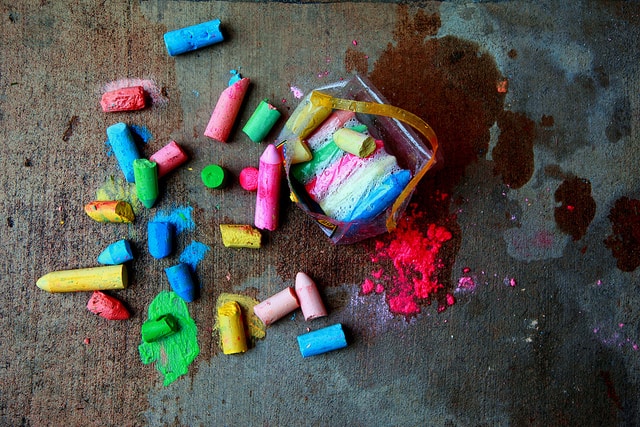When you were handed a piece of paper and a box of crayons as a kid, what did you draw?
I always drew a rainbow. I was so excited to use all of the colors in the box to make the most vivid rainbow possible—and I always loved seeing the colors all in order. I always found colors fascinating.
Colors are beautiful, but there’s so much more to them than meets the eye. Color psychology dictates that color can influence us emotionally and physiologically. Much more research must be done, but if utilized correctly, colors can influence us both emotionally and physically.
But first…
…What are “Warm” and “Cool” Colors?
It’s important to know the difference between warm and cool colors when considering color psychology.
Warm colors are exactly what they sound like: sunny and warm. They’re the reds, oranges, and yellows, the first half of the colors you used to take out of the box to make a rainbow as a kid. These are the “stimulating” colors—literally.
Studies have shown that warm colors make people feel excited and stimulated. In fact, you likely feel the physical symptoms after seeing warm colors more often than you think. In one study published in BMJ, researchers found that participants who took red pills instead of blue pills (both placebos) thought the pills were stimulants—and even exhibited stimulant symptoms.
Related: The Power of Positive Thinking
Cool colors, on the other hand, are the greens, blues, and purples—the innermost part of that rainbow. These are the more relaxing, less stimulating colors. People tend to associate a feeling of restfulness with these colors, and this can also translate into physical relaxation. In the same study in BMJ, the participants who took the blue placebo pills assumed they were depressants, and actually exhibited tranquilizing effects.
But what does this all mean? You can use color psychology in practical ways to improve your life.
How Colors Can Help You
1. Working Out: Keep it Warm
Feeling a little drained? Wear warm colors to the gym. Research has shown that warm colors, especially red, can stimulate you into action. One study published in Emotion found that seeing the color red can cause people to react with greater force and speed. Buying yourself some red gear might help you perform at your best physically.
2. Studying: Beware of the Red Pen
Studying for a big exam coming up? Avoid red! A study published in the Journal of Experimental Psychology found that participants who were exposed to red before an important test performed significantly poorer than those who were not. Researchers believe the reason is that we unconsciously associate red with the danger of failure. Try exposing yourself to more relaxing, cool colors.
Related: How to Get in Shape in 5 Simple Steps
3. Shopping: Don’t Fall for Color Gimmicks!
Companies use color psychology to get you to buy their stuff—so don’t be fooled! One study showed that many fashion stores use cool colors in their interior design, especially blue because you will be more likely to purchase their items.
Red is also often used in advertising because when we see red, we feel we must pay attention due to cues like red lights and stop signs. Be aware of the color used by companies and advertising to be a smarter shopper.
Related: How to Get Motivated From Within
4. Cleaning: Use Blue to Feel Squeaky Clean
Cheer detergent tested three different colors of flecks in their detergent: red, blue, and yellow. Though they were the exact same detergent other than the color, customers claimed that the yellow didn’t make their clothes clean enough, while the red flecks damaged their clothing. The blue detergent was the only one deemed high-quality.
For this reason, blue is often used by cleaning agencies to give us the illusion of cleanliness. If you want to use color psychology to feel clean and fresh, try wearing blue—or use blue soap to feel extra squeaky clean after your bath.
Related: How to Declutter Your Home
5. Relaxation: Use Green for a Grin
Need to relax? Surround yourself with a lovely shade of green! According to one study, green received the most positive responses than any other color and was associated with relaxation, calmness, and happiness. Researchers believe that the reason behind this is because we intrinsically associate green with nature and the outdoors.
If you have a room in your house that you use to relax, consider painting it green—just not yellow-green, since that induced nauseous feelings in participants!
Related: How to Achieve Mindfulness in 10 Minutes a Day
The Takeaway
There are still many studies to be done on color psychology, but the color is important to us physically and mentally. After all, if we didn’t need color, we wouldn’t have evolved to be able to see such a wide spectrum—and what a drab world that would be!
You can use color and color psychology to help influence your mood, improve your study habits, and even be a smart shopper. Try noticing those colors of the rainbow more often in your life—you might be surprised by what you find.
*************************
 Sammy Nickalls is the Content Manager at Inspiyr.com. She is an avid health nut and a lover of all things avocado. Follow her on Twitter or Pinterest.
Sammy Nickalls is the Content Manager at Inspiyr.com. She is an avid health nut and a lover of all things avocado. Follow her on Twitter or Pinterest.
Photo by Pink Sherbet Photography

